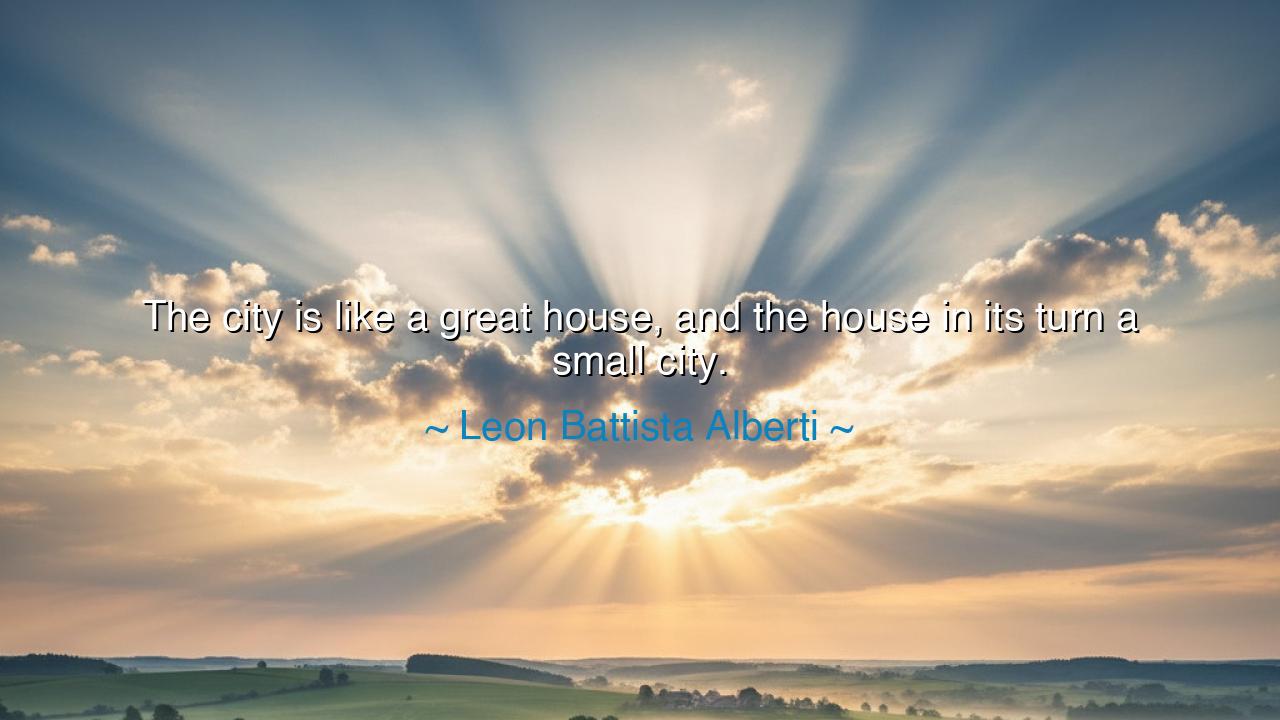
The city is like a great house, and the house in its turn a small






The great Renaissance thinker Leon Battista Alberti, master of architecture, philosophy, and human virtue, once said: “The city is like a great house, and the house in its turn a small city.” In these few words lies a vision both poetic and profound — a mirror between the private world and the public realm, between the dwelling of one family and the dwelling of an entire people. Alberti saw what many forget: that civilization begins at the threshold of one’s own home, and that the order, beauty, and harmony of a city are but the reflection of the hearts and habits of those who live within it.
When Alberti uttered these words, the world was awakening from the shadows of the Middle Ages. Cities like Florence, Venice, and Rome were rising again, their streets filled with merchants, artists, and thinkers who sought not merely survival but splendor — the harmonious union of form and purpose. As an architect and philosopher, Alberti believed that the architecture of a house was more than bricks and beams; it was a moral act, a testament to the soul of its inhabitants. And the architecture of a city was the same spirit magnified — a moral act made public, a grand composition where every home, every street, and every square sang together in the chorus of civilization.
Thus, when Alberti said that the city is like a great house, he meant that a city’s health depends upon the virtue of its households. A city filled with disorderly, selfish homes cannot be wise or just; but a city where each house reflects balance, cooperation, and care will flourish like a living organism. The household is the seed, and the city its flower. The way a family keeps its hearth, respects its neighbors, and educates its children becomes, in time, the measure of how a society governs itself, builds its institutions, and honors its people.
Consider the story of Florence in Alberti’s own time — a city of towering cathedrals and narrow streets, where artisans and families shaped the destiny of Europe. It was not the rulers alone who gave Florence its glory; it was the guilds, the families, the craftsmen who brought order and pride to their work. The Medici family, in particular, turned their household into a small city of learning and art, where painters like Botticelli and sculptors like Donatello were nurtured as part of the family’s moral and cultural duty. From the private home flowed public greatness. Florence became a living embodiment of Alberti’s wisdom: a city as noble as the homes within it.
There is also a deeper spiritual meaning in Alberti’s vision. For he teaches that architecture is the visible soul of a people. Just as a house shelters the body, so does a city shelter the spirit of its citizens. If the home is built with love, patience, and respect, it radiates these virtues outward; if the city is designed with harmony, dignity, and justice, it teaches these virtues to its children. The line between private and public life dissolves — each becomes the reflection of the other. To repair the city, one must first repair the home; to purify the nation, one must first purify the heart.
But beware, for when the balance is broken, when the home becomes selfish and the city corrupt, both crumble together. History is filled with the ruins of such civilizations — Rome, once radiant with order and art, fell not because of foreign swords, but because the households of Rome forgot virtue. The marble of her palaces cracked when the hearts of her citizens hardened. Alberti’s words, then, are both a song and a warning: what we build within ourselves, we build in the world.
So, dear listener, learn from this wisdom of the ancients. Let your house be a small city — ordered, loving, and just. Let your city be a great house — noble, inclusive, and alive with care. Sweep your threshold before you judge your neighbor’s street; cultivate peace in your home before you demand it in your nation. For the pattern of greatness begins in the quiet rhythm of daily life — in how we treat one another, in how we build, in how we dream.
And when each home becomes a sanctuary of kindness and beauty, the city shall rise like a cathedral of the human spirit — radiant, unified, and eternal. This was Alberti’s vision, and it remains our sacred duty: to build the world outside as we would build the home within — with harmony, compassion, and enduring strength.






AAdministratorAdministrator
Welcome, honored guests. Please leave a comment, we will respond soon